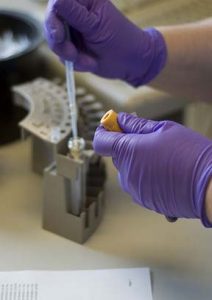
Why Are My Dog Or Cat’s ALT Blood Levels Abnormal
Alanine Aminotransferase ALT, previously called SGPT aka Glutamic Pyruvic Transaminase, GPT
Ron Hines DVM PhD
 See What Normal Blood & Urine Values Are
See What Normal Blood & Urine Values Are
 Causes Of Most Abnormal Blood & Urine Tests
Causes Of Most Abnormal Blood & Urine Tests
 What To Do When My Pet’s Liver Tests Are High?
What To Do When My Pet’s Liver Tests Are High?
The source of elevated ALT enzyme in your dog or cat’s lab report is primarily from injured (“leaking”) liver cells (hepatocytes). The ALT test is the frontline test for liver disease in dogs, cats and people. Results are usually included within the group of tests called a liver panel (=bilirubin, AST, ALT, GGT, and Alkaline phosphatase).
Health Problems That Can Cause too Much ALT To Be Present In Your Cat Or Dog’s Blood:
In cats, cholangiohepatitis, hepatic lipidosis are two common causes. Hyperthyroidism, IBD and diabetes are occasionally associated with elevated ALT in cats as well. In dogs, underlying Cushing’s disease or pancreatitis can be responsible.
Exposure to toxins, certain medications and corticosteroid administration can also elevate your dog and cat’s ALT level. In dogs, Trazodone, given to reduce anxiety has also been associated with liver damage and elevated ALT. (read here)
In dogs, heartworm disease or its treatment of the disease with Immiticide®/Diroban® elevates ALT levels. Hemolytic anemia, insufficient oxygen reaching the body (hypoxia), various metabolic disorders, over-exertion, severe body trauma and all the diseases that result in elevated AP can also elevate your pet’s ALT level.
Although the ALT is associated with the liver, occasionally adjoining bile duct disease that obstructs the normal flow of bile from your pet’s liver to its intestine can cause the amount of free ALT in its system to be elevated too.
Mild-to-moderate increases in ALT can also occur in pregnancy and, as I mentioned before, hyperthyroidism can cause a moderate increase in the ALT level of your cat.
Significant gum/dental disease in your dog or cat can also cause a moderate elevate in its ALT level. So can the NSAIDs given long term to dogs to treat arthritis or joint pain. Those NSAID drugs include Rimadyl®, Deramaxx®, Previcox®, Metacam®, Galliprant® etc. (read here)
An accidentally hemolyzed blood sample – particularly from a cat – can report a falsely elevated ALT result.
On rare occasions, chronic hepatitis might follow a leptospirosis infection. That can result in an elevation of a number of liver function tests. (read here)
It is not that unusual for a pet that appears healthy to occasionally have moderately higher than normal ALT, bilirubin or Alkaline Phosphatase levels with no apparent explanation or health consequences. Physicians face the same problem as veterinarians do when deciding what to do in those situations. (read here) I generally suggest that the test be repeated in 2-3 weeks to see if the results are still abnormal or dropping. Many times they have improved. I am also more concerned when a number of liver-related tests are a bit high than when only one of the tests is. Of course, if your pet is feeling poorly, has lost weight or the test result was quite high, waiting is not a good option.
Health Problems That Can Cause Too Little ALT To Be Present:
I know of none. Have the test repeated at a commercial veterinary laboratory or wait a few weeks and have the test run again at your local animal hospital.
Complementary tests:
fPL® in cats or cPL® test in dogs for possible pancreatitis in cats or in dogs, ultrasound examination of the liver, and all the complimentary tests that accompany a liver panel. It is often wise to repeat the ALT test in 3 weeks and thereafter to monitor the situation. The liver has a great capacity to regenerate. When liver cell damage has ceased, usually your pet’s ALT level will drop by one half in about 1-3 days and be normal within ~ 1-3 weeks.
Drugs associated with elevated ALT levels are the same ones that sometimes cause liver damage that raises your pet’s AP levels. They include:
Corticosteroids (such as prednisone/prednisolone), acetaminophen (Tylenol™), Non-steroidals such as Rimadyl® and Metacam® for arthritis. Griseofulvin dispensed to treat ringworm infections. Ketoconazole or fluconazole used to treat a variety of fungal infections. Isoflurane, halothane and methoyflurane anesthetic gases. Metronidazole (Flagyl®) dispensed for a variety of intestinal issues involving diarrhea. Fenbendazole (Panacur®) or mebendazole give to eliminate intestinal parasites. Various antitumor (“chemo”) medications. Phenobarbital given to treat seizures. Sulfonamide antibiotics and tetracycline.
Your pet will rarely face a toxicity issue with any of these medications if they are given in the accepted doses and intervals. Liver-related issues are often due to giving several of these drugs in combination or giving them at or above their maximum suggested doses. There will always be a pet now and then that does not react as expected to a drug that most pets have no problem receiving. We veterinarians blame that on genetic variation. One genetic variation that is commonly blamed are variations in P450. (read here)
DxMe
You are on the Vetspace animal health website
Visiting the products that you see displayed on this website help pay the cost of keeping these articles on the Internet.

